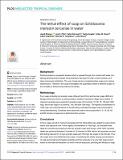| dc.description.abstract | Background
Schistosomiasis is a parasitic disease which is spread through skin contact with water containing Schistosoma cercariae. Drug treatment has been the main control method, but it does not prevent reinfection. The use of soap can be a complementary measure to reduce transmission. Therefore, this study investigates the quantitative effect of different soaps on the mortality of Schistosoma mansoni cercariae.
Methodology
Four soaps including two powder soaps (Kleesoft and Omo) and two bar soaps (B29 and Rungu) which are used in a schistosomiasis-endemic Tanzanian village were studied. S. mansoni cercariae were exposed to powder soaps of 0 (control), 10, 50, 75, 100 and 1000 mg/L and to bar soaps of 0 (control), 100, 500 and 1000 mg/L. The highest concentration of 1000 mg/L was selected based on the laboratory-estimated average soap concentration during handwashing. Cercariae were observed under a microscope after 0, 5, 15, 30, 45 and 60 minutes of exposure to determine their survival.
Conclusions
All four soaps can kill S. mansoni cercariae and this lethal effect was related to soap concentration and exposure time. At the highest concentration of 1000 mg/L, all cercariae were dead at 5 minutes post-exposure with two powder soaps and Rungu, while 100% cercarial death was achieved between 5 minutes to 15 minutes for B29. Almost all cercariae survived after being exposed to 10 mg/L powder soaps and 100 mg/L bar soaps for 60 minutes. Powder soaps were more lethal than bar soaps. Considering the widely varying concentrations of soap during real-world hygiene activities and the necessity for a very high soap concentration to eliminate all cercariae in a short 5-minute exposure, providing the efficacy of soap in preventing schistosomiasis becomes challenging. Future studies should investigate whether soap can influence alternative mechanisms such as making cercariae unable to penetrate the skin, thereby providing protection. | en_US |

